Multi-Factor Analysis and Graded Remediation Strategy for Goaf Stability in Underground Metal Mines: Fluid–Solid Coupling Simulation and Genetic Algorithm-Based Optimization Approach
Abstract
1. Introduction
2. Research Methods
2.1. Goaf Failure Theory and Stability Analysis
2.2. Stability Analysis of Goafs Based on FLAC3D 6.0
2.2.1. Basic Assumptions
- Continuum assumption: The rock mass is considered as a continuous, homogeneous, or quasi-homogeneous medium, ignoring distinct structural fractures, joints, and other discontinuities, so that its deformation and failure can be described using the theory of continuum mechanics.
- Equilibrium of initial stress and hydraulic conditions: It is assumed that the initial geostress field and pore water pressure field are in equilibrium at the time that the model is established. The distributions of initial stress, pore water pressure, and seepage conditions are considered to be stable.
- Simplified one-way coupling: The seepage field is computed first, followed by the updating of mechanical parameters for stress analysis.
- Fluid flow assumption: Fluid flow follows Darcy’s law, and hydraulic parameters such as permeability and porosity remain constant within a defined range. The fluid is assumed to be incompressible or only slightly compressible.
- Simplified mechanical constitutive model: Rock mass behavior is described by a classical elastoplastic constitutive relationship using the Mohr–Coulomb model, while neglecting temperature effects, chemical reactions, and other complex influences.
- Idealized boundary conditions: The far-field boundaries of the model are assumed to be fixed or subject to simple linear variations, ensuring that local disturbances in the goaf are not affected by unrealistic boundary effects.
2.2.2. Numerical Simulation Research Framework
2.2.3. Model Construction and Mesh Generation
2.2.4. Initial Stress Field and Selection of Representative Cross-Sections
2.2.5. Stability Analysis Results of Goaf Based on Numerical Simulation
- Analysis of Maximum and Minimum Principal Stresses
- 2
- Analysis of Plastic Zones and Maximum Displacement
- 3
- Pore Water Pressure Analysis
3. Research on the Governance of Goaf
3.1. Optimization of Goaf Remediation Sequence Based on Genetic Algorithm
- Mathematical Model Construction
- 2.
- Implementation Method
- (1)
- Stress normalization: Min–max normalization is employed to eliminate dimensional differences;
- (2)
- Population initialization: 50 sets of weight vectors are randomly generated, with the constraint ∑w = 1;
- (3)
- Selection mechanism: Roulette wheel selection is used to retain individuals with higher fitness, giving those with better fitness a greater probability of being preserved in the next generation;
- (4)
- Arithmetic crossover: A linear combination of parent individuals is performed with a probability of 80%, as follows:
- (5)
- Gaussian mutation: A normally distributed perturbation is added with a probability of 10%:
- (6)
- Termination condition: The maximum number of generations is set to 100, and the algorithm is terminated early if the optimal fitness shows no improvement for 20 consecutive generations.
- 3.
- Optimization Results of Goaf Remediation Sequence
3.2. Numerical Simulation Analysis of Goaf Remediation
4. Results
5. Conclusions
- The pillar width-to-height ratio and the cross-sectional area of the goaf are the most critical geometric factors influencing stability. Coupled groundwater pressure significantly affects the extent and distribution of plastic failure zones, particularly in deeper or water-bearing areas.
- The genetic algorithm effectively optimizes the sequence of backfilling operations, achieving a maximum reduction of 60.96% in principal stress and 28.6% in pore pressure, thereby demonstrating strong practical applicability.
- The proposed “assessment–optimization–governance” framework improves the rationality and efficiency of goaf remediation planning and can be extended to other mining sites facing similar goaf-related stability issues.
Author Contributions
Funding
Data Availability Statement
Acknowledgments
Conflicts of Interest
Abbreviations
| FoS | Safety Factor |
| GA | Genetic Algorithm |
| NSGA-II | Non-dominated Sorting Genetic Algorithm II |
| MDPI | Multidisciplinary Digital Publishing Institute |
| DOAJ | Directory of open-access journals |
| TLA | Three-letter acronym |
| LD | Linear dichroism |
References
- Lai, X.; Ren, F.; Wu, Y.; Cai, M. Comprehensive Assessment on Dynamic Roof Instability under Fractured Rock Mass Conditions in the Excavation Disturbed Zone. Int. J. Miner. Metall. Mater. 2009, 16, 12–18. [Google Scholar] [CrossRef]
- Ma, H.; Wang, Y.; Fu, S. Present Situation Analysis of Non-Coal Mine Goaf Hazards in China. J. North-East. Univ. 2009, 30, 91–95. [Google Scholar]
- Linjun, P.; Xiaojie, Y.; Xiaoming, S. Analysis and Control on Anomaly Water Inrush in Roof of Fully-Mechanized Mining Field. Min. Sci. Technol. China 2011, 21, 89–92. [Google Scholar] [CrossRef]
- Tesarik, D.R.; Seymour, J.B.; Yanske, T.R. Post-Failure Behavior of Two Mine Pillars Confined with Backfill. Int. J. Rock. Mech. Min. Sci. 2003, 40, 221–232. [Google Scholar] [CrossRef]
- Elmo, D.; Stead, D. An Integrated Numerical Modelling–Discrete Fracture Network Approach Applied to the Characterisation of Rock Mass Strength of Naturally Fractured Pillars. Rock. Mech. Rock. Eng. 2010, 43, 3–19. [Google Scholar] [CrossRef]
- He, M.-C.; Xie, H.-P.; Peng, S.-P.; Jiang, Y.-D. Study on Rock Mechanics in Deep Mining Engineering. Chin. J. Rock. Mech. Eng. 2005, 24, 2803–2813. [Google Scholar]
- Wu, Y.; Hu, J.; Xie, C.; Shi, D. Case Study on the Stability Control of Broken Surrounding Rock in Roadway Excavation on the Edge of a Collapsed Stope Area. Adv. Civ. Eng. 2021, 2021, 8658847. [Google Scholar] [CrossRef]
- Wu, M.; Hu, N.; Ye, Y.; Wang, Q.; Wang, X. Multi-Hazard Risk Characterization and Collaborative Control Oriented to Space in Non-Coal Underground Mines. Sci. Rep. 2022, 12, 16452. [Google Scholar] [CrossRef]
- Feng, X.-T.; Liu, J.; Chen, B.; Xiao, Y.; Feng, G.; Zhang, F. Monitoring, Warning, and Control of Rockburst in Deep Metal Mines. Engineering 2017, 3, 538–545. [Google Scholar] [CrossRef]
- Lapshyn, O.Y.; Lapshyn, O.O.; Khudyk, M. The Tragic Consequences of the Collapse of the Earth’s Surface within the Mining Allotment of Ordzhonikidze Mine. E3S Web Conf. 2020, 166, 03003. [Google Scholar] [CrossRef]
- Yu, D.; Yi, X.; Liang, Z.; Lou, J.; Zhu, W. Research on Strong Ground Pressure of Multiple-Seam Caused by Remnant Room Pillars Undermining in Shallow Seams. Energies 2021, 14, 5221. [Google Scholar] [CrossRef]
- Zhaoyuan, L.; Feng, C.; Jianwei, L.; Xingping, L.; Ruiqiang, Y. Dynamic Evolution Law and Width Determination of Section Coal Pillars in Deep Mining Height Working Face. Res. Sq. 2021. [Google Scholar] [CrossRef]
- Tian, Y.; Gong, P.; Zhao, T.; Yi, K.; Wen, G. Instability Prediction Model of Remaining Coal Pillars under Remining Disturbance. Energy Sci. Eng. 2023, 11, 1842–1857. [Google Scholar] [CrossRef]
- Su, R.; Shen, H. Physical Characteristics of Section Coal and Rock Pillars Under Roof Shock Disturbances from Goaf. Front. Phys. 2020, 8, 223. [Google Scholar] [CrossRef]
- Yi, S.; Zhang, Y.; Yi, H.; Li, X.; Wang, X.; Wang, Y.; Chu, T. Study on the Instability Activation Mechanism and Deformation Law of Surrounding Rock Affected by Water Immersion in Goafs. Water 2022, 14, 3250. [Google Scholar] [CrossRef]
- Wang, X.; Liu, W.; Jiang, X.; Zhang, Q.; Wei, Y. Evolution Characteristics of Overburden Instability and Failure under Deep Complex Mining Conditions. Geofluids 2022, 2022, 6418082. [Google Scholar] [CrossRef]
- Poulsen, B.A. Coal Pillar Load Calculation by Pressure Arch Theory and near Field Extraction Ratio. Int. J. Rock. Mech. Min. Sci. 2010, 47, 1158–1165. [Google Scholar] [CrossRef]
- Zhao, Q.; Yang, Z.; Jiang, Y.; Liu, X.; Cui, F.; Li, B. Discrete Element Analysis of Deformation Features of Slope Controlled by Karst Fissures under the Mining Effect: A Case Study of Pusa Landslide, China. Geomat. Nat. Hazards Risk 2023, 14, 1–35. [Google Scholar] [CrossRef]
- Lunder, P.; Pakalnis, R.C. Determination of the Strength of Hard-Rock Mine Pillars. CIM Bull. 1997, 90, 51–55. [Google Scholar]
- Esterhuizen, G.S.; Dolinar, D.R.; Ellenberger, J.L. Pillar Strength in Underground Stone Mines in the United States. Int. J. Rock. Mech. Min. Sci. 2011, 48, 42–50. [Google Scholar] [CrossRef]
- Fang, Z.; Harrison, J.P. Numerical Analysis of Progressive Fracture and Associated Behaviour of Mine Pillars by Use of a Local Degradation Model. Min. Technol. 2002, 111, 59–72. [Google Scholar] [CrossRef]
- Xie, X.-B.; Deng, R.-N. Stability of Goaf Group System Based on Catastrophe Theory and Rheological Theory. Rock. Soil. Mech. 2018, 39, 1963–1972. [Google Scholar]
- Zhao, Y.; Wu, Q. Strength Reduction Method to Study Stability of Goaf Overlapping Roof Based on Catastrophe Theory. Chin. J. Rock. Mech. Eng. 2010, 29, 11. [Google Scholar]
- Xu, Z.; Xu, W.; Zhu, Z.; Zhao, J. Research on Monitoring and Stability Evaluation of Ground Subsidence in Gypsum Mine Goaf. Front. Environ. Sci. 2023, 10, 1097874. [Google Scholar] [CrossRef]
- Jia, H.; Yan, B.; Guan, K.; Liu, H.; Wu, Q.; Yin, Y.; Liu, H. Stability Analysis of Shallow Goaf Based on Field Monitoring and Numerical Simulation: A Case Study at an Open-Pit Iron Mine, China. Front. Earth Sci. 2022, 10, 897779. [Google Scholar] [CrossRef]
- Hoek, E.; Carranza-Torres, C.; Corkum, B. Hoek-Brown Failure Criterion—2002 Edition. In Proceedings of the 5th North American Rock Mechanics Symposium and 17th Tunnelling Association of Canada Conference: NARMS-TAC 2002, Toronto, ON, Canada, 7–10 July 2002. [Google Scholar]
- Ren, Q.; Wang, F.; Chen, B.; Zhao, M.; Peng, Z.; Yang, M. Study on Stability Prediction of Pillars Based on Bieniawski Pillar Strength Formula: A Case of a Phosphate Mine. Geotech. Geol. Eng. 2020, 38, 4033–4044. [Google Scholar] [CrossRef]
- Biot, M.A. General Theory of Three-Dimensional Consolidation. J. Appl. Phys. 1941, 12, 155–164. [Google Scholar] [CrossRef]
- Katoch, S.; Chauhan, S.S.; Kumar, V. A Review on Genetic Algorithm: Past, Present, and Future. Multimed. Tools Appl. 2021, 80, 8091–8126. [Google Scholar] [CrossRef]
- Janiesch, C.; Zschech, P.; Heinrich, K. Machine Learning and Deep Learning. Electron. Mark. 2021, 31, 685–695. [Google Scholar] [CrossRef]
- Cheng, F.; Chen, A.; Wu, D.; Tang, X.; Su, C. Numerical Simulation of Cracking Failure and Weakening Law of Roadway Surrounding Rock under High Stress. Shock. Vib. 2021, 2021, 7236077. [Google Scholar] [CrossRef]
- Kravchuk, I.L.; Pikalov, V.A.; Nevolina, E.M.; Yutyaev, E.P.; Ivanov, Y.M. Specific Features of Mining Enterprises Safety Control Systems Formation and Functioning in Complicated Conditions of Deposits Development. Ugol’ 2017, 53, 60–67. [Google Scholar] [CrossRef][Green Version]
- Xu, X.; Fu, L.-Y.; Liu, N.; Han, T. On the Determination of Coordination Numbers of Coupled DEM-DFN Model for Modeling Fractured Rocks. Front. Earth Sci. 2021, 9, 665275. [Google Scholar] [CrossRef]
- Hosseini, E.; Sarmadivaleh, M.; Chen, Z. Developing a New Algorithm for Numerical Modeling of Discrete Fracture Network (DFN) for Anisotropic Rock and Percolation Properties. J. Pet. Explor. Prod. Technol. 2021, 11, 839–856. [Google Scholar] [CrossRef]
- Cundall, P.A.; Hart, R.D. Numerical Modeling of Discontinua. Eng. Comput. 1992, 9, 101–113. [Google Scholar] [CrossRef]
- Deb, K.; Pratap, A.; Agarwal, S.; Meyarivan, T. A Fast and Elitist Multiobjective Genetic Algorithm: NSGA-II. IEEE Trans. Evol. Comput. 2002, 6, 182–197. [Google Scholar] [CrossRef]
- Ou, D.; Tan, K.; Du, Q.; Chen, Y.; Ding, J. Decision Fusion of D-InSAR and Pixel Offset Tracking for Coal Mining Deformation Monitoring. Remote Sens. 2018, 10, 1055. [Google Scholar] [CrossRef]
- Jia, H.; Yan, B.; Yang, Z.; Yilmaz, E. Identification of Goaf Instability under Blasting Disturbance Using Microseismic Monitoring Technology. Geomech. Geophys. Geo-Energy Geo-Resour. 2023, 9, 142. [Google Scholar] [CrossRef]
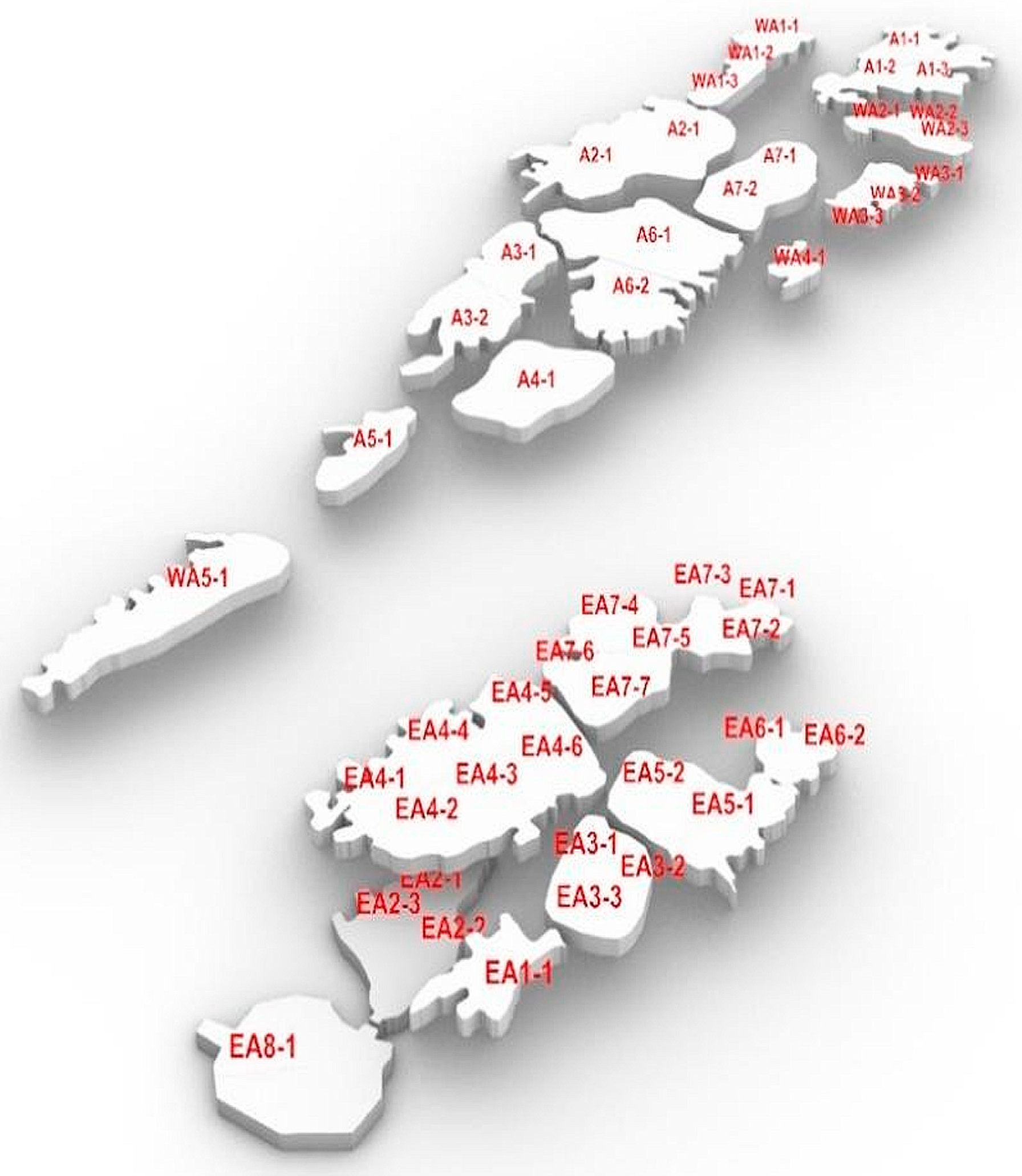
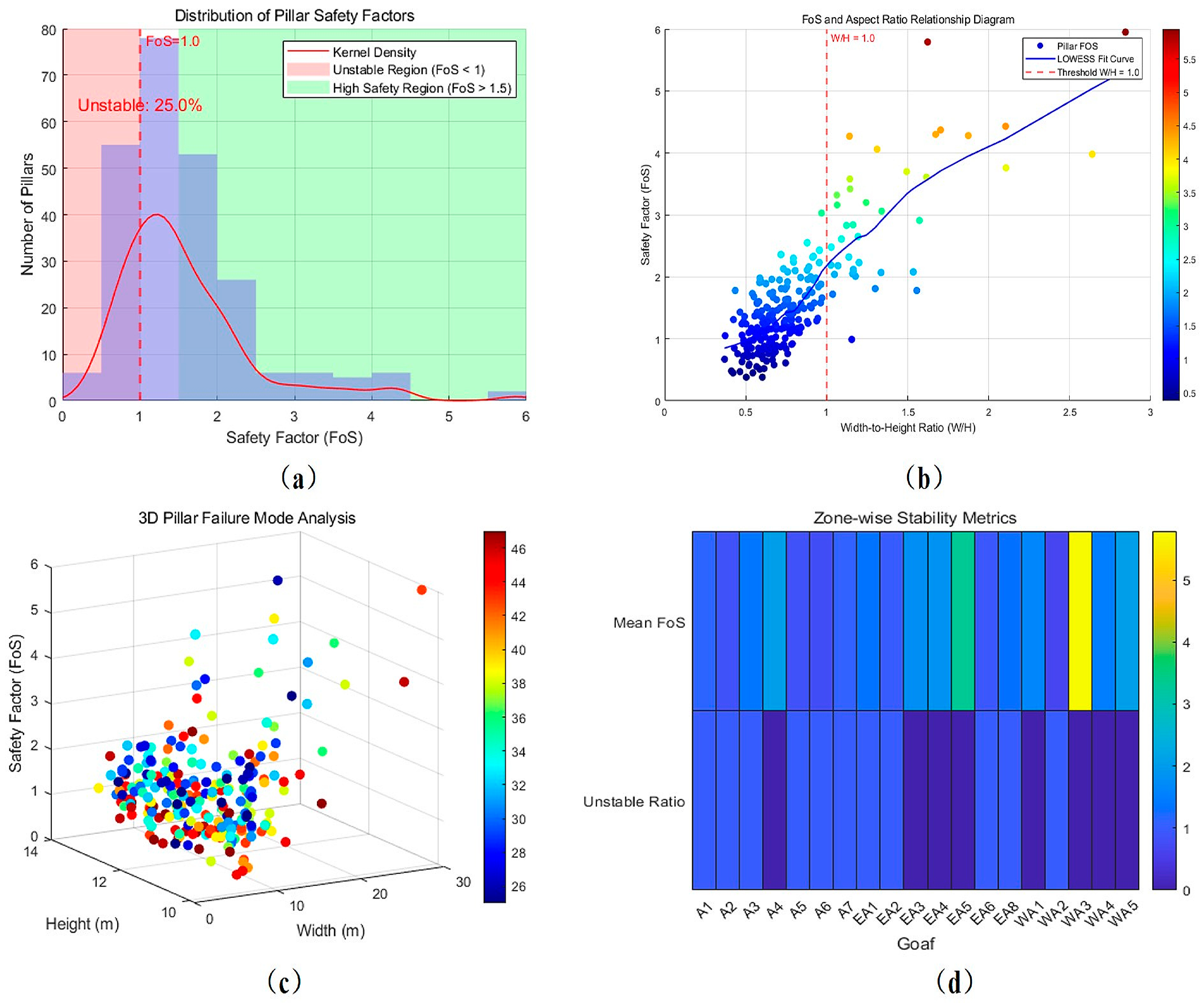
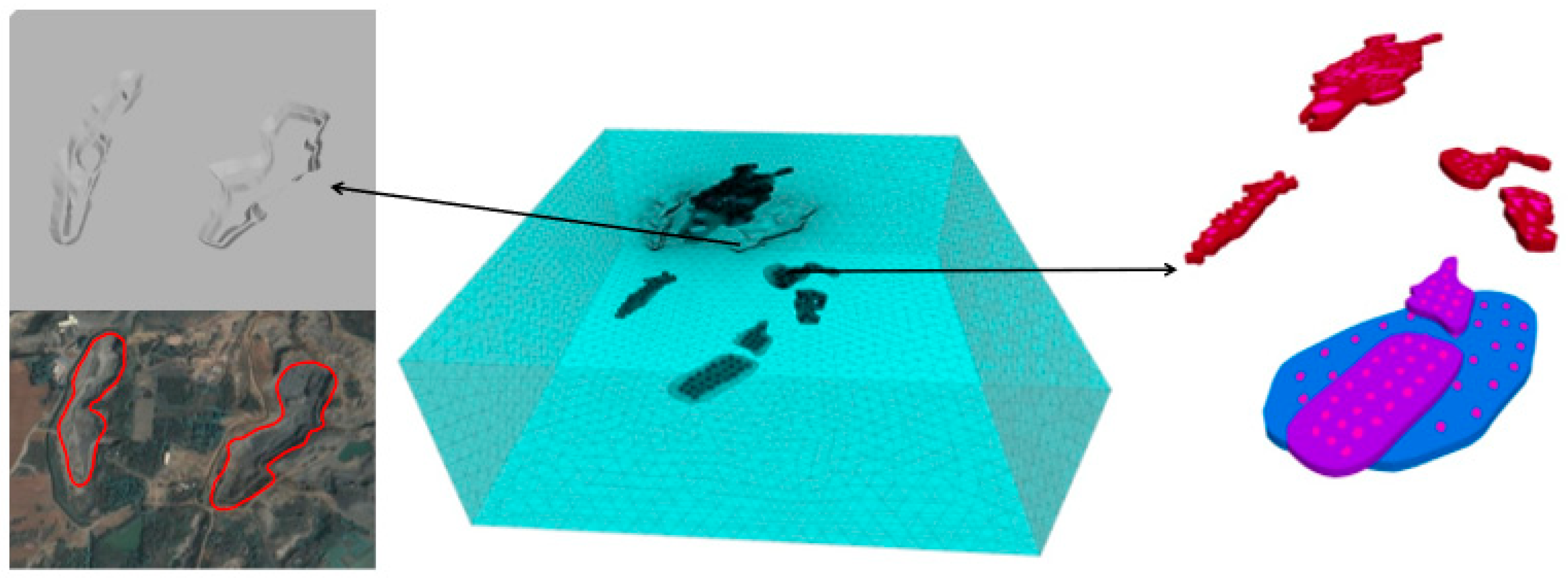

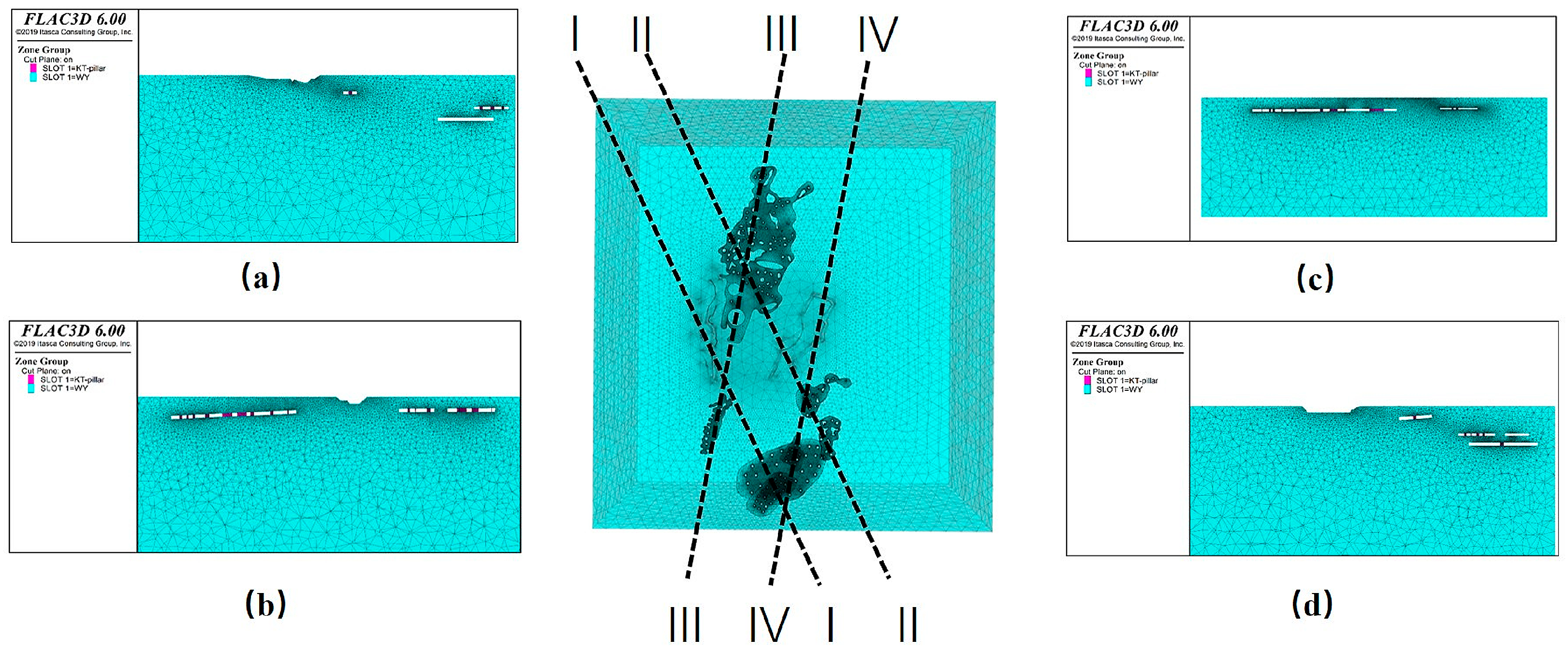


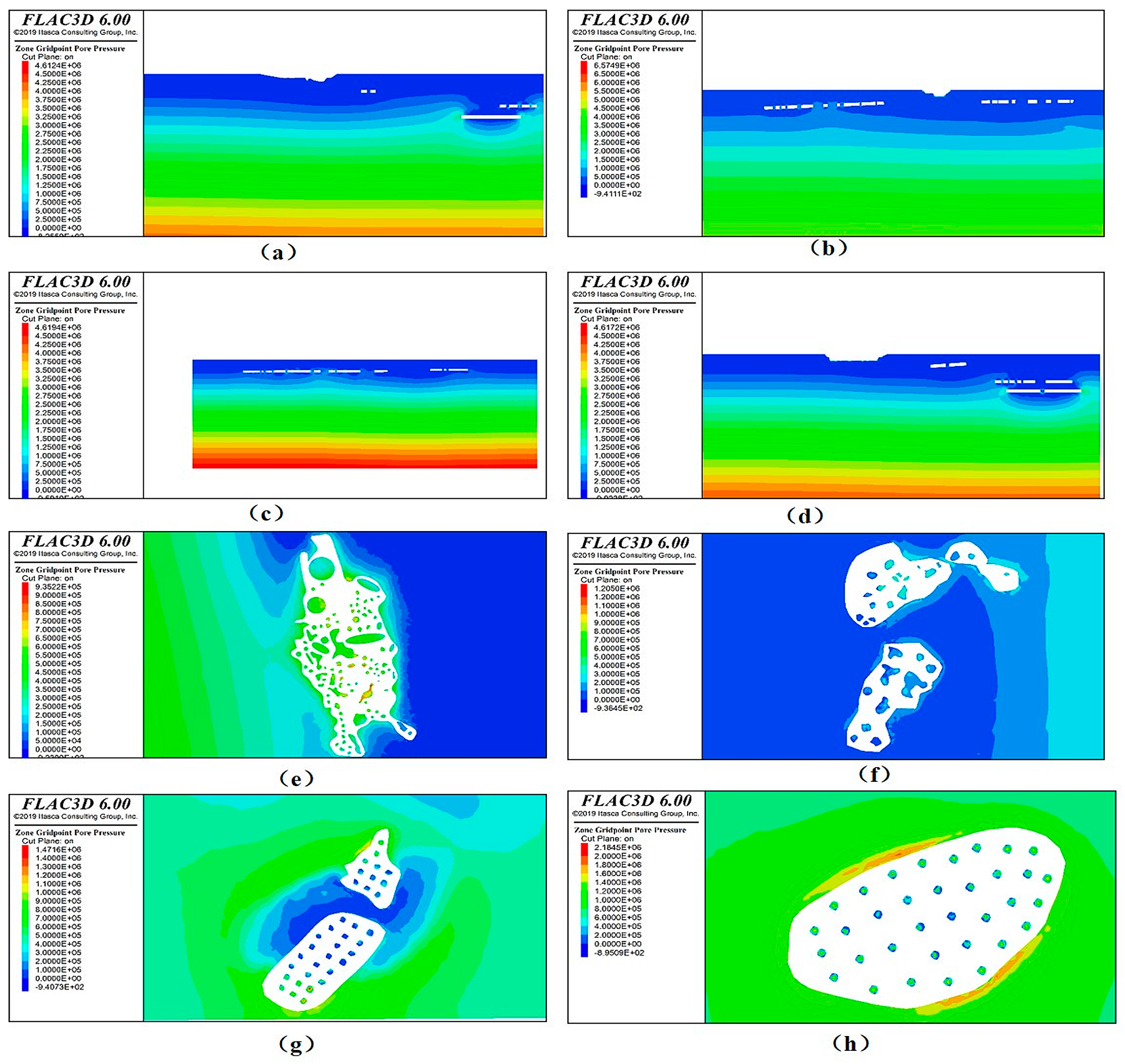
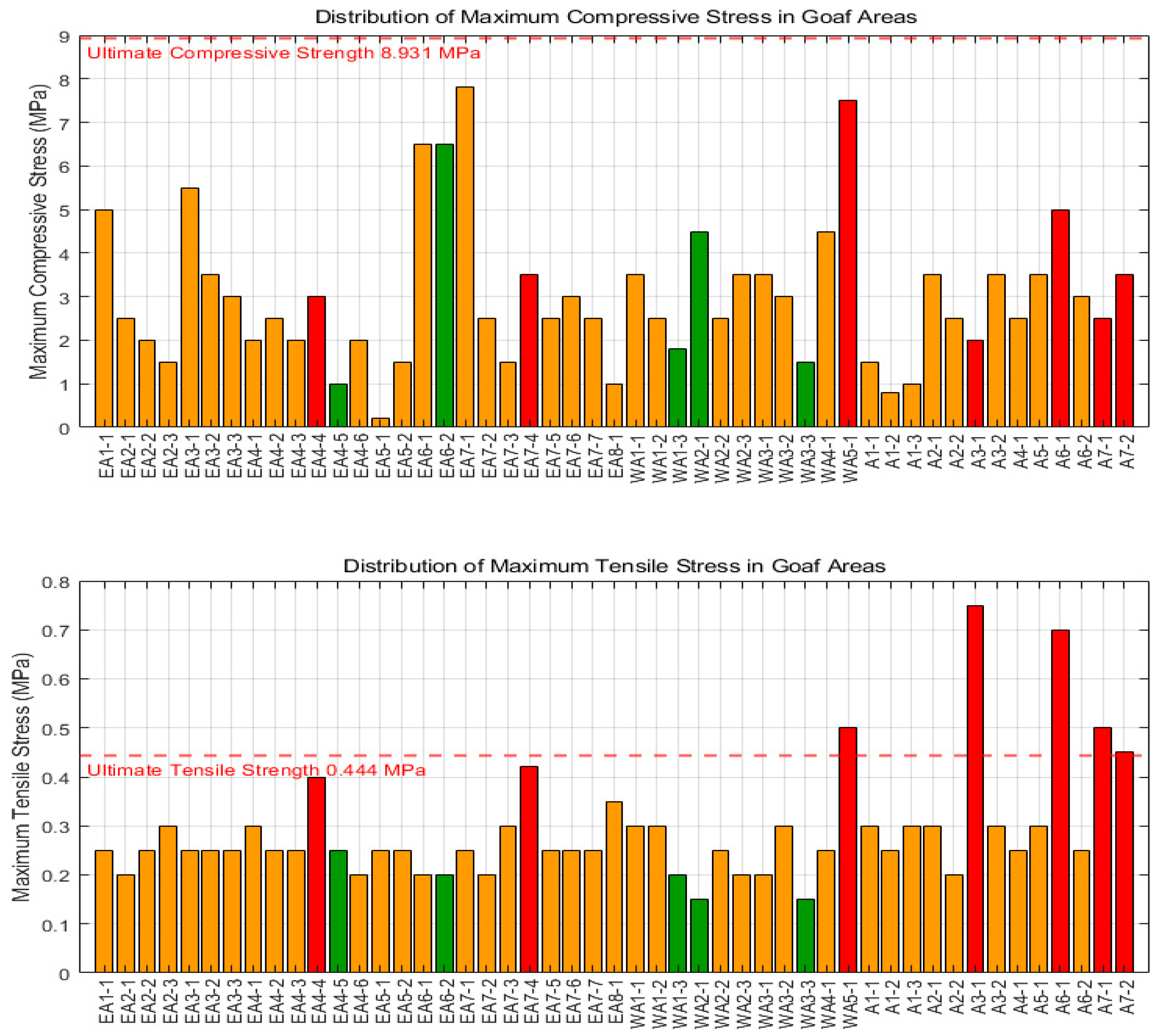
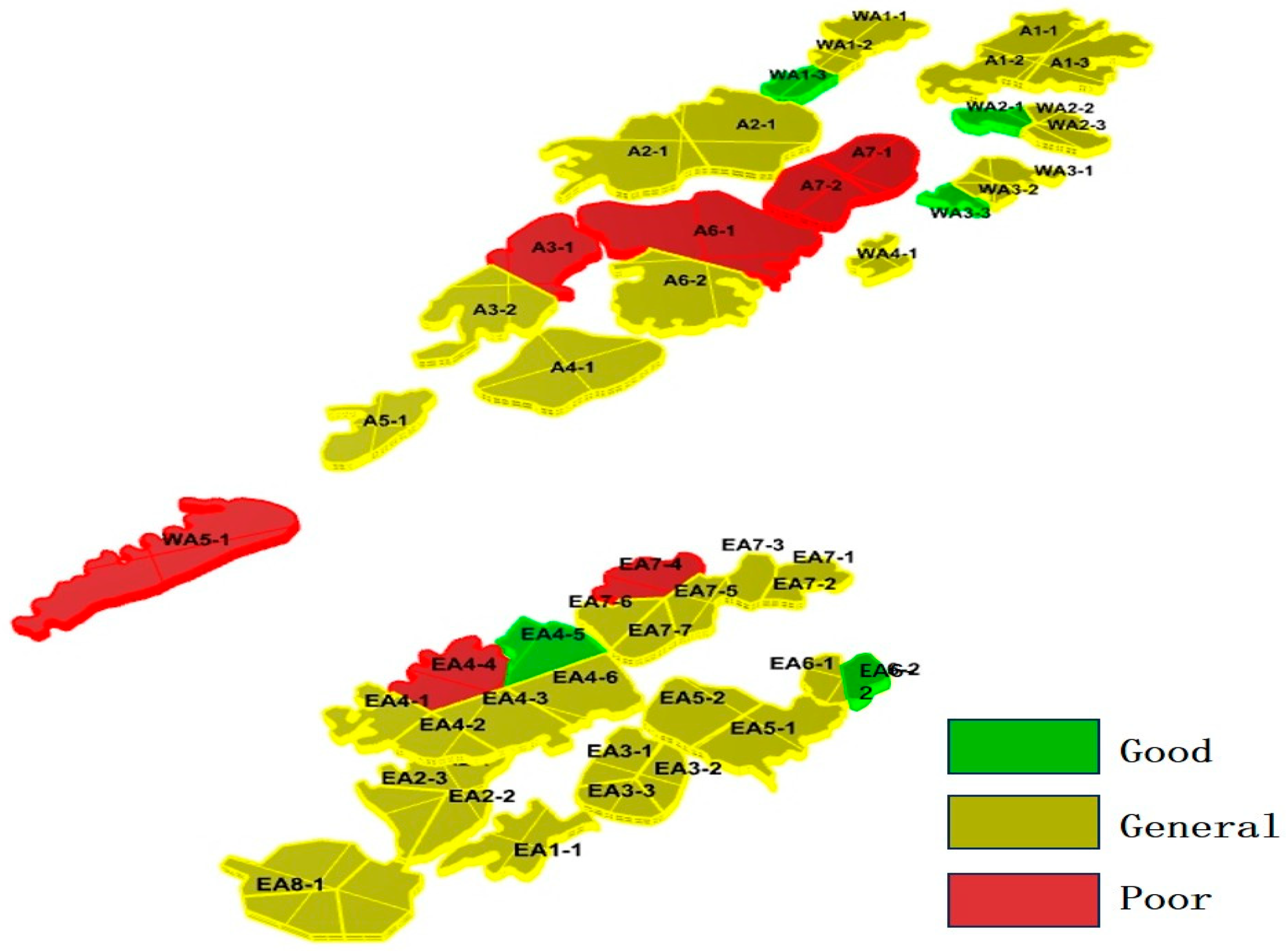
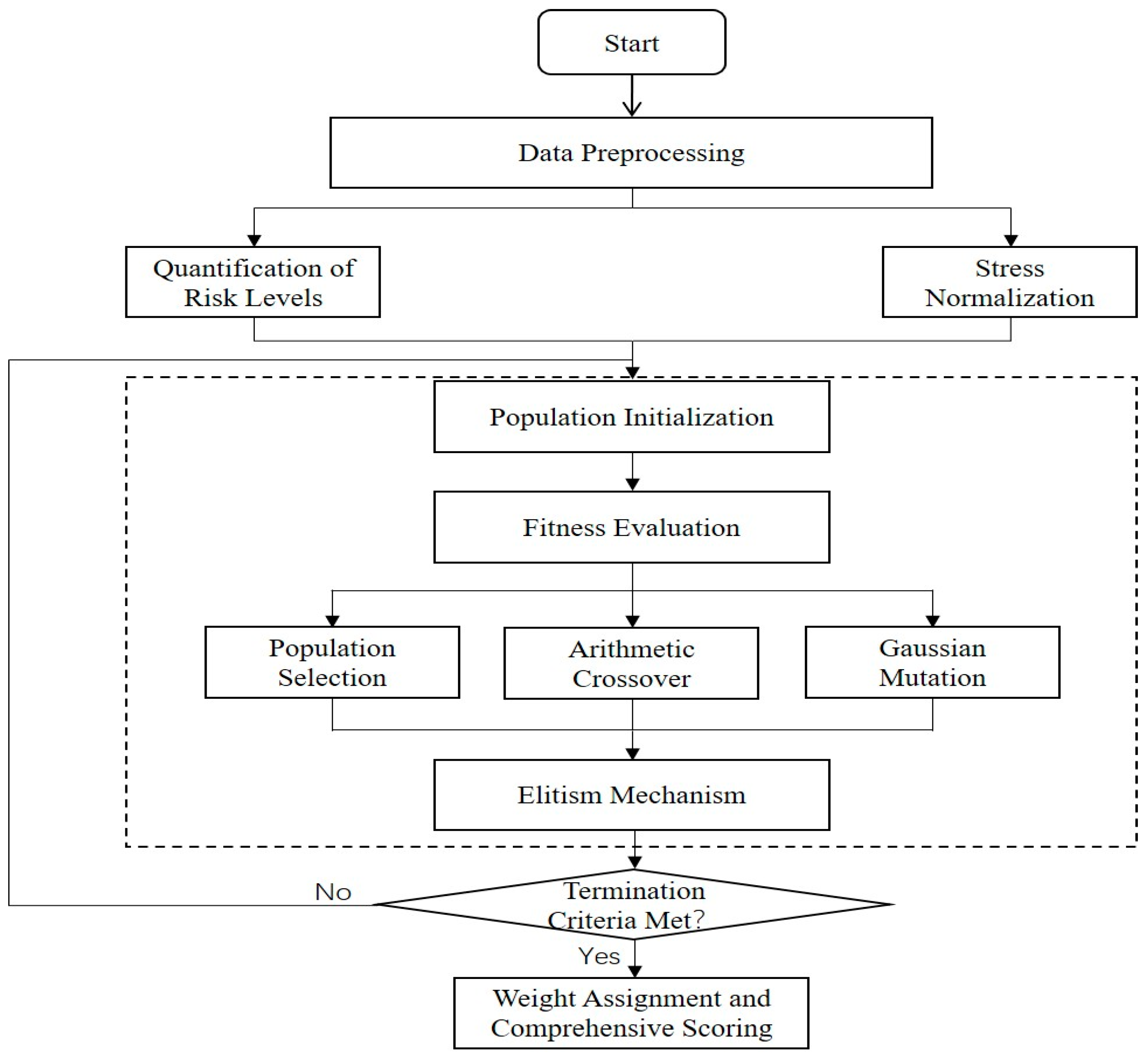

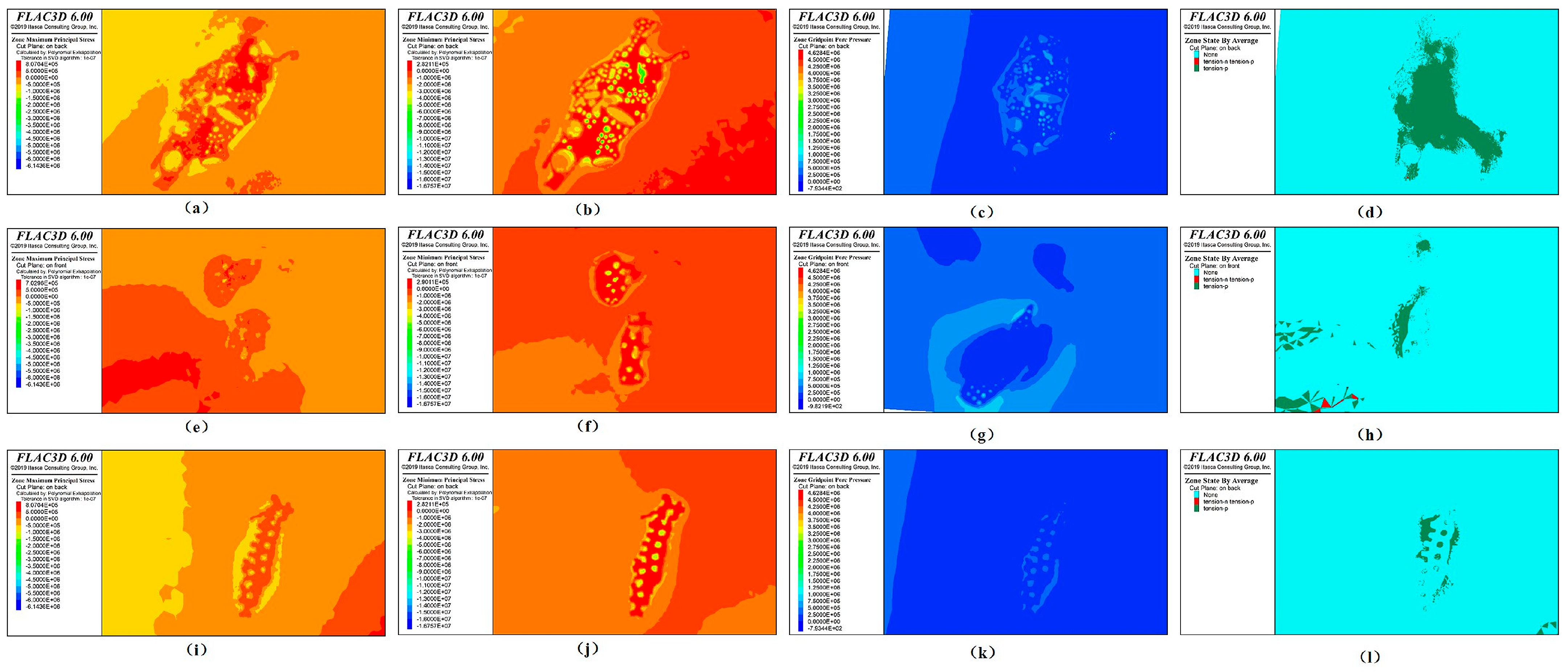
| Rock Sample | Phase | Compressive Strength (MPa) | Elastic Modulus (GPa) | Tensile Strength (MPa) | Cohesion (MPa) | Friction Angle (°) |
|---|---|---|---|---|---|---|
| Surrounding Rock | Saturated | 15.124 | 13.876 | 0.444 | 1.337 | 51.06 |
| Ore Body | Saturated | 8.931 | 7.088 | 0.201 | 0.780 | 46.48 |
| Backfill Body | Tensile Strength (MPa) | Compressive Strength (MPa) | Elastic Modulus (MPa) | Poisson’s Ratio | Cohesion (MPa) | Friction Angle (°) | Unit Weight (KN/m3) |
|---|---|---|---|---|---|---|---|
| Cemented Rockfill | 0.39 | 4.5 | 1.48 | 0.28 | 0.35 | 30 | 22 |
| Uncemented Rockfill | 0.01 | 0.5 | 0.3 | 0.3 | 0.30 | 36 | 13.4 |
| Goafs | Max. Principal Stress Before (MPa) | Max. Principal Stress After (MPa) | Change Rate of Max. Stress (%) | Min. Principal Stress Before (MPa) | Min. Principal Stress After (MPa) | Change Rate of Min. Stress (%) | Pore Water Pressure Before (MPa) | Pore Water Pressure After (MPa) | Change Rate of Pore Water Pressure (%) |
|---|---|---|---|---|---|---|---|---|---|
| West-wing goaf group | 1.432 | 0.807 | −43.65 | 0.281 | 0.230 | −18.15 | 0.8 | 0.75 | −6.25 |
| East-wing goaf group | 1.798 | 0.702 | −60.96 | 0.669 | 0.290 | −56.65 | 0.350 | 0.250 | −28.6 |
| WA-5 goaf group | 0.856 | 0.807 | −5.7 | 0.292 | 0.281 | −3.8 | 0.250 | 0.450 | +80.0 |
Disclaimer/Publisher’s Note: The statements, opinions and data contained in all publications are solely those of the individual author(s) and contributor(s) and not of MDPI and/or the editor(s). MDPI and/or the editor(s) disclaim responsibility for any injury to people or property resulting from any ideas, methods, instructions or products referred to in the content. |
© 2025 by the authors. Licensee MDPI, Basel, Switzerland. This article is an open access article distributed under the terms and conditions of the Creative Commons Attribution (CC BY) license (https://creativecommons.org/licenses/by/4.0/).
Share and Cite
Yuan, X.; Li, X.; Li, X.; Su, T.; Du, H.; Zhu, D. Multi-Factor Analysis and Graded Remediation Strategy for Goaf Stability in Underground Metal Mines: Fluid–Solid Coupling Simulation and Genetic Algorithm-Based Optimization Approach. Symmetry 2025, 17, 1024. https://doi.org/10.3390/sym17071024
Yuan X, Li X, Li X, Su T, Du H, Zhu D. Multi-Factor Analysis and Graded Remediation Strategy for Goaf Stability in Underground Metal Mines: Fluid–Solid Coupling Simulation and Genetic Algorithm-Based Optimization Approach. Symmetry. 2025; 17(7):1024. https://doi.org/10.3390/sym17071024
Chicago/Turabian StyleYuan, Xuzhao, Xiaoquan Li, Xuefeng Li, Tianlong Su, Han Du, and Danhua Zhu. 2025. "Multi-Factor Analysis and Graded Remediation Strategy for Goaf Stability in Underground Metal Mines: Fluid–Solid Coupling Simulation and Genetic Algorithm-Based Optimization Approach" Symmetry 17, no. 7: 1024. https://doi.org/10.3390/sym17071024
APA StyleYuan, X., Li, X., Li, X., Su, T., Du, H., & Zhu, D. (2025). Multi-Factor Analysis and Graded Remediation Strategy for Goaf Stability in Underground Metal Mines: Fluid–Solid Coupling Simulation and Genetic Algorithm-Based Optimization Approach. Symmetry, 17(7), 1024. https://doi.org/10.3390/sym17071024





